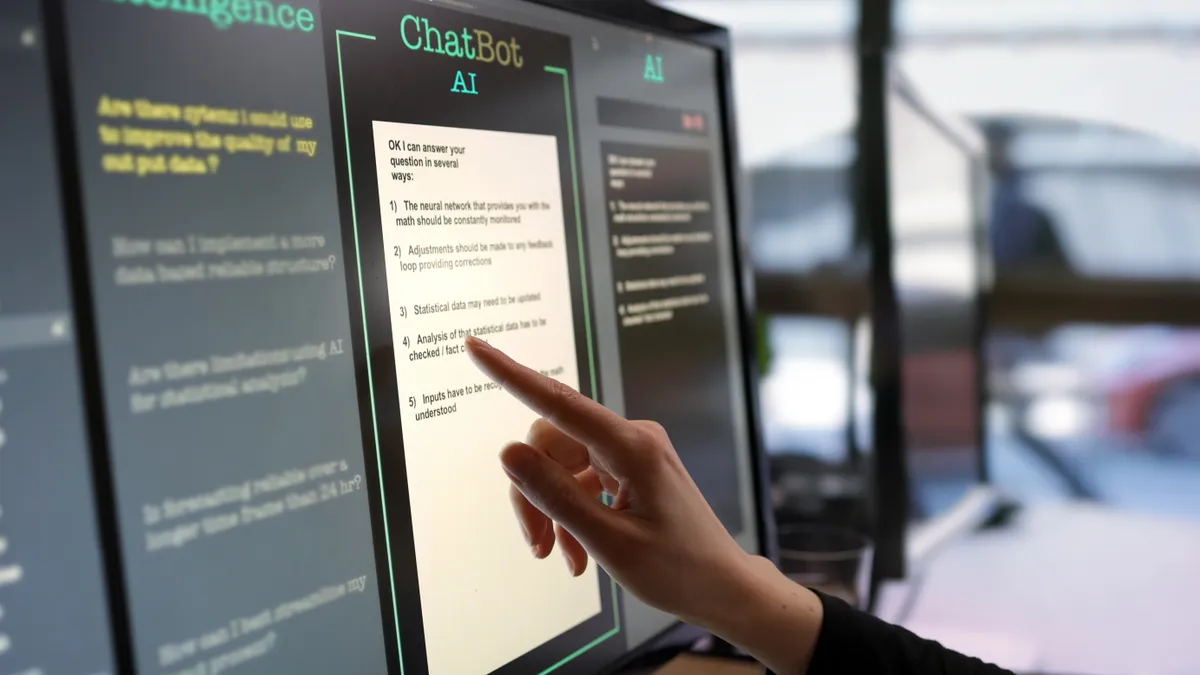AI holds the power to enable new experiences in everything from shopping to customer service, but the technology needs to take its first steps before it can take off in a run.
Data crunching is one of the least exciting deployments for AI, but it may also be the most important application at the onset of 2025. Data is the base more advanced features, like agentic AI, are built upon, and companies ignore it at their own risk.
“If you don't get the foundations right, if you don't take the time to establish clear principles and operating processes, I think people are risking customer trust,” Isabelle Zdatny, principal catalyst at Qualtrics XM Institute, told CX Dive. “You just have one breach of trust and customers are going to leave you for someone else.”
In a way, generative AI can help create a foundation for more advanced generative AI. Companies early in their journey can use the technology to improve their data-gathering capabilities. In the short term, this can lead to significant, if mundane, personalization improvements — while setting up the necessary infrastructure for entirely new features in the coming years.
AI hasn’t lived up to its hype just yet, but it’s getting close, according to Zdatny. The unexciting work companies put in this year will help position them for a future CX revolution, making 2025 about “just getting your house in order.”
Better insights are the starting point
For many companies, generative AI may be better suited toward improving insights into customer behavior than wowing those customers with new experiences.
Many leaders recognize this. The technology’s top expected CX benefit was “better customer insights that lead to better products and services,” according to a 2024 Gartner survey.
Insights were “significantly ahead” of the next top responses, which were “more personalized sales/service interactions” and “more tailored product/service recommendations,” respectively, according to Maria Marino, VP analyst at Gartner.
Marino expects AI features introduced by voice of the customer platforms to gain popularity in the coming year. Potential applications include employee-facing conversational assistants that suggest next best actions, better personalize customer-facing communications and help create solutions to customer journey pain points.
More advanced use cases could gain momentum toward the end of the year, according to Marino. Potential uses include prompting generative AI to dynamically create customer personas and journey maps based on real-time customer data and feedback.
While better data and customer insights won’t lead to better experiences by itself, this application of the technology can form the backbone for more advanced capabilities. Companies that act too early and create chatbots trained on bad data can expect disappointing results, according to Zdatny.
“AI compounds the garbage in, garbage out issue,” Zdatny said. “If your data is isolated and messy, the AI models are not going to be able to produce surprisingly rich, valuable insights.”
AI has its place personalization
Early applications of AI can shore up important elements of the greater experience picture, even if the technology won't create entirely new experiences at this stage.
AI isn’t necessarily doing anything new in personalization, but it can help companies improve the scale of their efforts, according to Trinadha Kandi, managing director and the leader of the advertising, marketing and commerce practice at Deloitte Digital.
Many companies say they’re handling personalization well, but their customers don’t necessarily agree. Consumers only describe 43% of their experiences as personalized, while brands say they personalize 61% of experiences on average, according to a June 2024 Deloitte Digital survey.
Currently, most personalization is limited to experiences targeting specific segments, offers or products, according to Kandi. AI can help deliver personalization on a more individualized level.
“There is a huge gap between personalization expectations and reality,” Kandi said. “Now, with AI coming into play, it is going to definitely help the leaders to deliver the personalization at scale.”
Company leadership may want to keep in mind that while AI can help with personalization, it’s not the only element that matters.
Ulta Beauty is planning for significant investments in its personalization efforts this year, Josh Friedman, VP of digital products at Ulta Beauty, said at National Retail Federation’s Big Show earlier this month. He acknowledged that there is an “AI tailwind” assisting the company’s efforts, but that the technology isn’t the main force driving the push.
“We feel like there's a big opportunity there, from a technology perspective, to do it quicker, better, faster, at lower marginal costs,” Friedman said at a conference earlier this month. “But the real impetus is to make sure that we're taking care of our customers in a really hyper relevant way, because we owe it to her to do that based on her loyalty.”
The retailer is exploring changes to its company structure and employee responsibilities to foster a customer-first mindset that will improve personalization efforts, according to Friedman. The company is also aiming to collect more data directly from customers to fuel its data efforts.
AI offers a self-reinforcing system
The cost of the infrastructure necessary to support advanced AI use cases, combined with the necessary data foundation, can be prohibitive. While generative AI is trickling down into mainstream use, it is not yet fully democratized.
Only 37% of CIOs reported that their company has already deployed generative AI, according to an October 2024 Gartner survey of more than 3,100 CIOs. Another 35% indicated their company is planning to roll out generative AI solutions within the next year.
However, some larger companies have a head start. Amazon rolled out a conversational shopping assistant last year, while Walmart designed its own proprietary LLMs to support its AI ambitions, which includes plans to display individualized home pages for shoppers by the end of 2025.
The companies on the leading edge of AI investments are the only ones capable of deploying truly transformative CX applications this early in the technology’s infancy, according to Zdatny. This could give them an advantage in the near future.
“These are self-reinforcing, self-optimizing, self-learning systems,” Zdatny said. “Maybe this advantage will disappear over time, but I would say in the medium term the organizations that get virtual assistants out the door are going to stand out in a crowded market.”
However, that doesn’t mean small- to medium-size companies are doomed to be left in the dust. They can leverage some of AI’s less exciting capabilities to lay the groundwork that will help them catch up to the leaders, according to Zdatny.
“It's not just data that's collected through conversations like contact center interactions or behavioral data from websites,” Zdatny said. “They'll also be able to scrape social media and online reviews and government data sets to get more data into the system.”





















